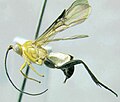Agathidinae
| Agathidinae | |
|---|---|

| |
| Female of an unidentified genus with elongate gena. | |
| Scientific classification | |
| Domain: | Eukaryota |
| Kingdom: | Animalia |
| Phylum: | Arthropoda |
| Class: | Insecta |
| Order: | Hymenoptera |
| Family: | Braconidae |
| Subfamily: | Agathidinae |
| Tribes | |
Agathidinae is a subfamily of braconid parasitoid wasps. Some species have been used in biological control programs.[1]
Description
[edit]Agathidines are among the larger braconids, and diurnal members of this subfamily are often brightly patterned. They belong to the noncyclostome group.[citation needed] Several genera, such as Agathis, Cremnops and Disophrys, are characterized by elongate genae.[1]
Agithidines can be recognized by the following combinations of features: forewing veins M + CU not tubular in basal third or more, forewing vein RS complete to the wing margin (except Mesocoelus and Plesiocoelus), occipital carina absent, and second submarginal cell of forewing usually present (90% of species.)[1]
Distribution
[edit]They are found worldwide, but are more diverse in the tropics. However, some genera such as Agathis and Earinus are more speciose in temperate regions.[1][2]
Biology
[edit]Most Agathidines are solitary koinobiont endoparasitoids of concealed Lepidoptera larvae. However, the tribe Disophrini attacks free living Lepidoptera larvae. The tribes Agathidini and Earinini attack the first and second instar larvae of their hosts, contrasting with the Disophrini, which attack later instars, as well as the Cremnoptini, which parasitize every larval stage. Most species are diurnal, but many Disophrini are nocturnal, with pale coloration and enlarged ocelli.[1]
Taxonomy and phylogeny
[edit]The first attempt at a tribal arrangement for Agathidinae consisted of 2 tribes, Agathidini and Microdini. Sharkey revised the tribes in 1992 and considered 5 tribes, adding Cremnoptini, Disophrini, and Earini. The Microdini, then treated as Eumicrodini, was synonymized under Agathidini by Simbolotti and van Achterberg in 1999 to render 4 tribes. Phylogenetic analysis by Sharkey and Chapman in 2017 revealed that 4 tribes were insufficient and instead divided the subfamily into 7 tribes. They further found that the genera Asperagathis, Bassus, and Zosteragathis were not monophyletic. One problematic species, the Nearctic Bassus annulipes, was found to represent a complex of species. Further, Bassus annulipes was rendered under the tribe Lytopylini while the Old World species fell under Agathidini.[3]
Relationship with humans
[edit]Agathidines have been used for biological pest control. Notable examples include Agathis pumila for the western larch case-bearer, Alabagrus stigma for the sugarcane borer, and Bassus unicoloratus for the potato tuberworm.[1]
Genera
[edit]The 63 genera placed here include:[4][3]
Tribe Agathidini Haliday, 1833
[edit]- Aerophilus Szépligeti, 1902
- Agathacrista Sharkey, 2013
- Agathigma Sharkey, 2017
- Agathis Latreille, 1804
- Alabagrus Enderlein, 1920
- Aphelagathis Sharkey, 2015
- Asperagathis Sharkey, 2017
- Bassus Fabricius, 1804 (polyphyletic)
- Braunsia Kriechbaumer, 1894
- Camptothlipsis Enderlein, 1920
- Chimaeragathis Sharkey, 2017
- Cymagathis Sharkey, 2017
- Gyragathis van Achterberg & Long, 2010
- Ischnagathis Cameron, 1909
- Leuroagathis Sharkey, 2017
- Liragathis Sharkey, 2017
- Neothlipsis Sharkey, Parys & Clutts, 2011
- Pharpa Sharkey, 1986
- Plesiocoelus van Achterberg, 1990
- Pneumagathis Sharkey, 2015
- Scabagathis Sharkey, 2017
- Trachagathis Viereck, 1913
- Trochantagathis Sharkey, 2017
- Xanthagathis Sharkey, 2017
- Zamicrodus Viereck, 1912
- Zosteragathis Sharkey, 2017
Tribe Agathirsini Sharkey, 2017
[edit]- Agathirsia Westwood, 1882
- Crassomicrodus Ashmead, 1900
- Gelastagathis Sharkey, 2015
- Marjoriella Sharkey, 1983
Tribe Cremnoptini Sharkey, 1992
[edit]- Cremnops Foerster, 1862
- Cremnoptoides van Achterberg & Chen, 2004
- Hyrtanommatium Enderlein, 1920
- Labagathis Enderlein, 1920
- Megalagathis Schulz, 1906
- Mesoagathis Cameron, 1905
- Zacremnops Sharkey & Wharton, 1985
Tribe Disophrini Sharkey, 1992
[edit]- Coccygidium Saussure, 1892
- Coronagathis van Achterberg & Long, 2010
- Disophrys Förster, 1863
- Euagathis Szépligeti, 1900
- Gyrochus Enderlein, 1920
- Hemichoma Enderlein, 1920
- Hypsostypos Baltazar, 1963
- Liopisa Enderlein, 1920
- Macroagathis Szépligeti, 1908
- Monophrys van Achterberg, 1988
- Oreba Cameron, 1900
- Pelmagathis Enderlein, 1920
- Protroticus van Achterberg, 1988
- Troticus Brullé, 1846
- Zelodia van Achterberg, 2010
- Zelomorpha Ashmead, 1900
- Chilearinus Sharkey, 2022[5]
- Earinus Wesmael, 1837
Tribe Lytopylini Sharkey, 2017
[edit]- Amputoearinus Sharkey, 2006
- Austroearinus Sharkey, 2006
- Lytopylus Förster, 1862
- Sesioctonus Viereck, 1912
- Smithagathis Sharkey, 2017
Tribe Mesocoelini Achterberg, 1990
[edit]- Aneurobracon Brues, 1930 (formerly in Orgilinae)
- Mesocoelus Schulz, 1911 (formerly in Orgilinae)
- Therophilus Wesmael, 1837
- Undescribed genus (former Bassus annulipes group)[3]
Gallery
[edit]-
Agathidini - Alabagrus texanus
-
Agathirsini - Agathirsia sp.
-
Cremnoptini - Megalagathis sp.
-
Disophrini - Coccygidium sp.
-
Earini - Earinus elator
-
Lytopylini - Lytopylus sp.
-
Mesocoelini - Therophilus sp.
References
[edit]- ^ a b c d e f Wharton, Robert; Marsh, Paul; Sharkey, Michael (1997). Manual Of The New World Genera Of The Family Braconidae (Hymenoptera). Washington DC: The International Society of Hymenopterists.
- ^ Sharkey, Michael J. (1997). "Agathidinae". In Wharton, Robert A.; Marsh, Paul M.; Sharkey, Michael J. (eds.). Manual of the New World Genera of the Family Braconidae (Hymenoptera) (PDF). Washington DC: The International Society of Hymenopterists. p. 69.
- ^ a b c Sharkey, Michael J.; Chapman, Eric G. (2017). "Phylogeny of the Agathidinae (Hymenoptera: Braconidae) with a Revised Tribal Classification and the Description of a New Genus". Proceedings of the Entomological Society of Washington. 119 (sp1): 823–842. doi:10.4289/0013-8797.119.SpecialIssue.823.
- ^ Sharkey, Michael (2006). "Two new genera of Agathidinae (Hymenoptera: Braconidae) with a key to the genera of the New World" (PDF). Zootaxa. 1185: 37–51. doi:10.11646/zootaxa.1185.1.3. Archived from the original (PDF) on 2020-09-22. Retrieved 2017-06-14.
- ^ Sharkey, Michael J.; Baker, Austin; Manjunath, Ramya; Hebert, Paul D.N. (2022). "Description of Chilearinus Sharkey gen. nov. and status of Nearctic Earinus Wesmael, 1837 (Braconidae, Agathidinae) with the description of new species". ZooKeys (1099): 57–86. Bibcode:2022ZooK.1099...57S. doi:10.3897/zookeys.1099.81473. PMID 36761440.







